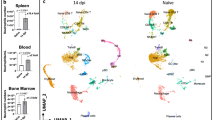Abstract
The eosinophil-associated ribonucleases (Ears) are rapidly evolving proteins found in multigene clusters that are unique to each rodent species. Of the 15 independent genes in the Mus musculus cluster, only mEars 1 and 2 are expressed at significant levels at homeostasis. Here we characterize the expression of mEar 6 in the liver and spleen in mice in response to infection with the helminthic parasite, Schistosoma mansoni. Interestingly, expression of mEar 6 is not directly related to the elevated levels of serum IL-5 or tissue eosinophilia characteristic of this disease, as no mEar 6 transcripts were detected in the liver or the spleen from uninfected IL-5-transgenic mice. The coding sequence of mEar 6 has diverged under positive selection pressure (Ka/Ks>1.0) and has a unique unpaired cysteine near the carboxy-terminus of the protein. The high catalytic efficiency of recombinant mEar 6 (kcat/Km=0.9 × 106/M/s) is similar to that of the cluster's closest human ortholog, eosinophil-derived neurotoxin (EDN/RNase 2). In summary, we have identified mEar 6 as one of only two RNase A superfamily ribonucleases known to be expressed specifically in response to pathophysiologic stress in vivo.
This is a preview of subscription content, access via your institution
Access options
Subscribe to this journal
Receive 6 digital issues and online access to articles
$119.00 per year
only $19.83 per issue
Buy this article
- Purchase on Springer Link
- Instant access to full article PDF
Prices may be subject to local taxes which are calculated during checkout




Similar content being viewed by others
References
Lander ES, Linton LM, Birren B et al. Initial sequencing and analysis of the human genome. Nature 2001; 409: 860–921.
Riordan J, D'Alessio G . Ribonucleases: Structures and Functions. Academic Press: San Diego, 1997.
Beintema JJ, Kleineidam RG . The ribonuclease A superfamily: general discussion. Cell Mol Life Sci 1998; 54: 825–832.
Beintema JJ, Schuller C, Irie M, Carsana A . Molecular evolution of the ribonuclease superfamily. Prog Biophys Mol Biol 1988; 51: 165–192.
Rosenberg HF . The eosinophil ribonucleases. Cell Mol Life Sci 1998; 54: 795–803.
Rosenberg HF, Dyer KD, Tiffany HL, Gonzalez M . Rapid evolution of a unique family of primate ribonuclease genes. Nat Genet 1995; 10: 219–223.
Zhang J, Rosenberg HF, Nei M . Positive Darwinian selection after gene duplication in primate ribonuclease genes. Proc Natl Acad Sci USA 1998; 95: 3708–3713.
Zhang J, Dyer KD, Rosenberg HF . Evolution of the rodent eosinophil-associated RNase gene family by rapid gene sorting and positive selection. Proc Natl Acad Sci USA 2000; 97: 4701–4706.
Larson KA, Olson EV, Madden BJ et al. Two highly homologous ribonuclease genes expressed in mouse eosinophils identify a larger subgroup of the mammalian ribonuclease superfamily. Proc Natl Acad Sci USA 1996; 93: 12370–12375.
Singhania NA, Dyer KD, Zhang J et al. Rapid evolution of the ribonuclease A superfamily: adaptive expansion of independent gene clusters in rats and mice. J Mol Evol 1999; 49: 721–728.
Cormier SA, Yuan S, Crosby JR et al. TH2-mediated pulmonary inflammation leads to the differential expression of ribonuclease genes by alveolar macrophages. Am J Respir Cell Mol Biol 2002; 27: 678–687.
Cormier SA, Larson KA, Yuan S et al. Mouse eosinophil-associated ribonucleases: a unique subfamily expressed during hematopoiesis. Mamm Genome 2001; 12: 352–361.
Nittoh T, Hirakata M, Mue S, Ohuchi K . Identification of cDNA encoding rat eosinophil cationic protein/eosinophil-associated ribonuclease. Biochim Biophys Acta 1997; 1351: 42–46.
McDevitt AL, Deming MS, Rosenberg HF, Dyer KD . Gene structure and enzymatic activity of mouse eosinophil-associated ribonuclease 2. Gene 2001; 267: 23–30.
Moreau JM, Dyer KD, Bonville CA et al. Diminished expression of an antiviral ribonuclease in response to pneumovirus infection in vivo. Antiviral Res 2003; 59: 181–191.
Yang D, Rosenberg HF, Chen Q et al. Eosinophil-derived neurotoxin (EDN), an antimicrobial protein with chemotactic activities for dendritic cells. Blood 2003; 102: 3396–3403.
Sabin EA, Kopf MA, Pearce EJ . Schistosoma mansoni egg-induced early IL-4 production is dependent upon IL-5 and eosinophils. J Exp Med 1996; 184: 1871–1878.
Dent LA, Strath M, Mellor AL, Sanderson CJ . Eosinophilia in transgenic mice expressing interleukin 5. J Exp Med 1990; 172: 1425–1431.
Tominaga A, Takaki S, Koyama N et al. Transgenic mice expressing a B cell growth and differentiation factor gene (interleukin 5) develop eosinophilia and autoantibody production. J Exp Med 1991; 173: 429–437.
Rosenberg HF, Domachowske JB . Eosinophils, eosinophil ribonucleases, and their role in host defense against respiratory virus pathogens. J Leukoc Biol 2001; 70: 691–698.
Zhang J, Zhang YP, Rosenberg HF . Adaptive evolution of a duplicated pancreatic ribonuclease gene in a leaf-eating monkey. Nat Genet 2002; 30: 411–415.
Hoffmann KF, McCarty TC, Segal DH et al. Disease fingerprinting with cDNA microarrays reveals distinct gene expression profiles in lethal type 1 and type 2 cytokine-mediated inflammatory reactions. FASEB J 2001; 15: 2545–2547.
Rosenberg HF, Domachowske JB . Eosinophil-derived neurotoxin. Methods Enzymol 2001; 341: 273–286.
Bystrom J, Wynn TA, Domachowske JB, Rosenberg HF . Gene microarray analysis reveals interleukin-5-dependent transcriptional targets in mouse bone marrow. Blood 2004; 103: 868–877.
Acknowledgements
We are deeply indebted to Dr James Lee and Dr Nancy Lee, Mayo Scottsdale, for their generous gift of polyclonal anti-mEars antiserum and to Dr Klaus Matthaei, Australian National University, Canberra, Australia, for his gift of RNA samples from IL-5 transgenic mice. We are also grateful to the staff of the NIAID 14BS Animal Facility for the care of the mice used in these studies. This work was partly supported by a JSPS Research Fellowship for Japanese Biomedical and Behavioral Researchers at NIH (2004–2006).
Author information
Authors and Affiliations
Corresponding author
Rights and permissions
About this article
Cite this article
Nitto, T., Dyer, K., Mejia, R. et al. Characterization of the divergent eosinophil ribonuclease, mEar 6, and its expression in response to Schistosoma mansoni infection in vivo. Genes Immun 5, 668–674 (2004). https://doi.org/10.1038/sj.gene.6364143
Received:
Revised:
Accepted:
Published:
Issue Date:
DOI: https://doi.org/10.1038/sj.gene.6364143
Keywords
This article is cited by
-
The RNase a superfamily: Generation of diversity and innate host defense
Molecular Diversity (2006)



